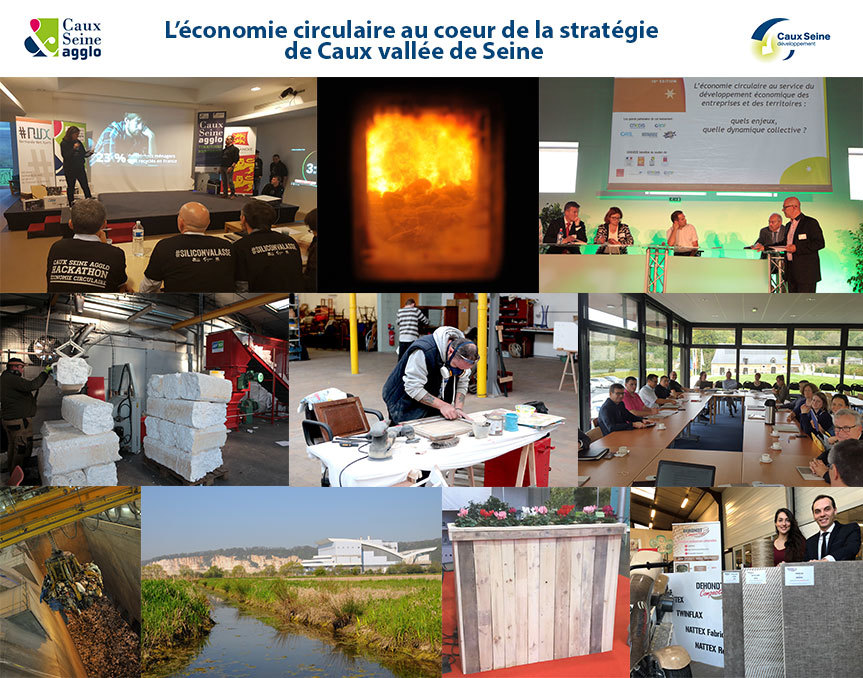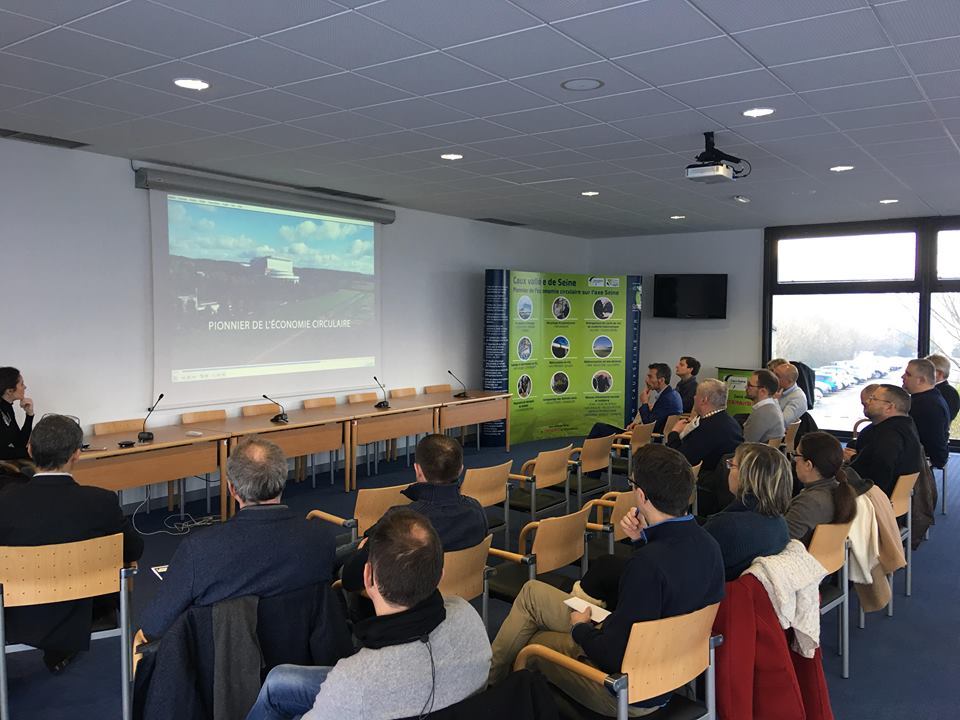INNOVATION THROUGH THE CIRCULAR ECONOMY TO STRENGTHEN THE ECONOMIC ATTRACTIVENESS OF THE AREA AROUND THE RIVER SEINE
Project details
- Main leader : Caux Seine agglo
- Type of initiative :
- Périmètre : Caux Seine Agglo
- Localisation : Allée du Catillon, 76170 Lillebonne
- Date de début : février 1972
Economy circular topics
- Extending useful service life
- Industrial and regional ecology
- Recycling
- Responsible consumption
- Functional service economy
- Eco-design
- Sustainable procurement
RECOGNIZED EXPERTISE AS A PIONEER IN CIRCULAR ECONOMY, IN THE AREA AROUND THE RIVER SEINE
Caux Seine agglo is an area that has long been home to industry.
After the golden age of textile industries around the valley in the 18th and 19th centuries, the area underwent a make-over in the early 20th century with the arrival of petrochemicals and chemistry.
This industrial experience made it into a cutting-edge area: companies developed there, and the particularly favourable ecosystem that they found there allowed them to develop new concepts, and be ever more innovative and dynamic.
Looking to the future, Caux Vallée de Seine is now positioned in two new development areas: digital and the circular economy.
The local authority has always shown itself to be innovative. For decades, it has been organizing its area and ensuring that businesses have the support they need to grow.
Today, Caux Seine agglo has several years of expertise in circular economy to help it anticipate the necessary diversification of its economic fabric and thereby be part of the construction of the new industrial France.
Under the leadership of its President In 2008, the "Grenelle de l'Estuaire" (estuary round table) demonstrated the potential of an industrial ecology approach for the area and for the Seine Estuary. So it was that in 2010, the Estuary Industrial Ecology Association (Association Ecologie Industrielle Estuaire - AEIE) was created. One of its missions was to seek out opportunities for industrial symbiosis in Port-Jérôme.
The circular economy is in the limelight today, but Caux Seine agglo has been working for on the subject 40 years, and also on the challenges for the different sectors across the area.
The area took these economic transition issues on board very early on, and has positioned itself as a pioneer in this sector, in the River Seine area. In 1972, the area hosted an industrial water plant managed by Caux Seine agglo, intended to pool resources with manufacturers. It is also the largest of the 3 existing plants in France.
The circular economy is an answer to the indispensable transformation of the industrial base which, along with Exxon, Oril and Revima, constitutes the wealth of the Caux Vallée de Seine urban area (30% of the local GDP).
“This industrial area has always been able to change”, as Jean-Claude Weiss, President of the urban area, explains, “and although there are many uncertainties in the long term, we must turn them into opportunities to prepare for the future by taking up the challenge of the energy transition”
In January 2017, the area acquired a new economic development agency: Caux Seine développement, with the status of Local Public Company (Société Publique Locale - SPL), a strong arm for territorial attractiveness. This agency is equipped with new skills to better meet the major challenges of the circular economy, innovation and attractiveness.
Caux Seine agglo and its economic development agency anticipate changes and make the circular economy into a lever to make this strongly industrial area more attractive.
Coming to Caux Seine agglo, companies know that they are joining an ecosystem that is today essential for the development and sustainability of their activities.
Also involved in the energy transition, the Caux Seine agglo area has for many years been helping to drive the emergence of industrial symbiosis and the development of events that raise awareness of these collaborative initiatives.
Qualitative benefits
Caux Seine agglo and Caux Seine développement are attentive to the needs of local people in order to anticipate economic changes.
The circular economy is an area of investment for the region to facilitate collaboration and provide support for companies in the development of their projects so as to create momentum between people involved in the local economic.
This more virtuous, value-creating economy is one of the levers of attractiveness in Caux Vallée de Seine, helping to link up people in the area and allow new projects to be implemented and developed while optimizing material and immaterial flows.
Its history, its industrial and rural identity, the diversity of projects and people involved in sustainable development ... all this reinforces the territory's determination to sustain a regional and global circular economy policy in order to help local businesses become better acquainted with each other, improve their competitiveness and their environmental performance by materializing synergies to create a virtuous economic ecosystem
Stages of the initiative
Caux Seine Valley is an area with an industrial vocation, highly involved in the energy transition (it was an award-winner in the "Territoires 100% EnR" system in the Normandy Region) and in the circular economy, on the basis of over 40 years of networked economic development.
In addition, the area was a forerunner in industrial and regional ecology within the Estuary, by requesting a first study of regional metabolism on the subject in 2009.
One of the obstacles to the deployment of a circular economy initiative lies in getting stakeholders involved and maintaining a dynamic network.
In Caux Vallée de Seine, it turns out that the quality of the network of companies led by the region for many years is contributing to the development of partnership projects in favour of the circular economy.
Companies must be made aware of the cooperative approach so that the development of a circular economy project can be effective and this joint culture can best meet their expectations.
In addition, the success of these projects depends today on the presence of this regional network supported by tightly-knit field cooperation with the services of the State, the Region, ADEME, Institut de l’économie circulaire and the development of partnerships with local bodies (chambers of commerce, competitiveness clusters, associations, professional federations, etc.).
The different support systems (financial, expertise, etc.) provided by the Institutions are important levers for accelerating the implementation of a circular economy approach.
The region aims to implement as many synergies as possible between all those involved: to raise awareness and make good practices more widespread, attract new businesses, develop their activities, anchor their skills within the region and thereby help to make Caux Vallée de Seine more attractive.
The area has chosen the following slogan: “Normandy is [re]invented here”, also with reference to the economic changes taking place in the area, the energy transition and digital, major issues in Caux Vallée de Seine.
Potential obstacles to the creation and sustainability of a circular ecosystem:
Regulations are changing rapidly and frequently, particularly with regard to products that leave waste status, which is a complex issue.
Certain companies for whom the circular economy is not their core business, may be dissuaded from changing their economic model when they realize what means need to be implemented: time, cost, risk- taking, etc. This is where the role of the region and its partners is essential to provide support as this change takes place..
The emergence of circular strategies requires a strong political signal from the area, cross-functional organisation, cooperation with the bodies mentioned above, a systemic, sustainable-development-oriented vision ... what the area has been engaged in for several decades.
Areas of activity
- Agriculture
- Crafts
- Chemistry
- Energy
- Industry
- Transport
- Recycling
- Trade
The area’s main sectors of activity,are impacted by the work carried out in Caux Vallée de Seine, namely:
- petrochemicals and fine chemicals,
- the subcontracting network linked to this industrial activity,
people involved in social economy.
Resources
- Materials
- Water
- Waste
- Biowaste
- Wood
- Chemicals
- Sobriety
- Material efficiency
- Energy efficiency
- Use
- Paper
- Cardboard
- Plastic
- Textiles
- Electronics
- Biogas
- Compost
- Unavoidable and recovered energy
- Methanation
- Wind power
- Heating networks
- Natural gas
Pillar(s) of the circular economy
- Extending useful service life
- Industrial and regional ecology
- Recycling
Technical resources
The urban areas’ departments have been structured to stimulate the circular economy and support the project owners, namely: - The regional cooperation and innovation department (Direction de la coopération et de l’innovation Territoriale) was created in late 2016 to deal with innovative projects, particularly those related to the circular economy. - January 2017 saw the creation of the Local Public Company (Société Publique Locale - SPL) Caux Seine développement with a position dedicated to the circular economy.Human resources
A project manager, acting as coordinator, supported by the other departments of the urban area and the economic development agency: communication, the study of waste, digital, innovation hub, regional marketing, etc.
Elected representatives promote the values of the circular economy during their talks, reminding those involved that the community is acting in favour of this economy. This is also a way to promote and make good practices and projects more widespread.
Financers
- Parmi les financeurs : Caux Seine agglo et son agence de développement Caux Seine développement (pour les études menées et les manifestations, groupes de travail et projets de territoire réalisés types GDZA, Hackathon, table ronde…. Soutien financier de
Web link(s)
http://hackathon.cauxseine.fr/•http://normandinamik.cci.fr/21706-faire-rimer-ecologie-et-industrie-tel-est-le-pari-de-l-association-ecologie-industrielle-estuaire
http://www.cauxseine.tv/category/tdd-2017/


